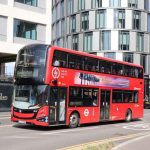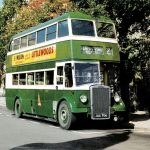An end to diesel engines and increasing focus on zero-emission hints at the UK’s future vehicle goals. Where does that leave biogas?
On 4 July 2017 Nottingham City Transport (NCT) launched a double-decker bus powered by a spark-ignited gas engine – its first biogas bus.
- An end to diesel engines and increasing focus on zero-emission hints at the UK’s future vehicle goals. Where does that leave biogas?
- Biogas: A worthwhile project
- Future is electric?
- More needed by government
- Biogas fleet growth still planned
- Zemo: ‘All tools are necessary’
- Technology agnostic
- Europe loves biogas?
- Biogas bus take up remains conspicuously more prevalent in Europe than in Britain.
- Research of bus registration data in western Europe and Poland between 2012-2020 by Chatrou CME Solutions shows that compressed natural gas (CNG) buses make up 2,636 of a fleet total of 7,478 alternative driveline coaches and buses, outnumbering the 2,062 registered battery-electric vehicles and beaten only just by 2,733 hybrid vehicles.
- In addition to the growth of CNG take up, there has been growth of CNG engines in the intercity and even the coach segment. Of the 2,636 CNG buses registered in western Europe, 413 were in the coach and intercity segments.
That set the stage for a £42m investment programme and has seen the company acquire a fleet of 120 gas-powered buses over the last four years. Even now, NCT Engineering Director Gary Mason says that gas bus procurement isn’t going to stop any time soon.
And why not? On 17 March, the company was honoured in the Chartered Institute of Logistics and Transport’s (CILT’s) Awards for Excellence with the Environmental Improvement Award. NCT’s fleet emissions have been reduced by 90% through the operation of a fully Euro VI compliant fleet, aided by the acquisition of gas-powered buses.
But growing intensity on the focus for zero tailpipe emissions and an eventual ban on the manufacture of internal combustion engines (ICEs) suggest electric, whether by battery, hydrogen or other means, is being promoted as the way forward for operators of bus fleets. Does gas still have a future?
Biogas: A worthwhile project
It perhaps does not come as a surprise to learn that Gary believes gas-powered vehicles, particularly when the gas sourced is biomethane, are very much viable options in a net zero carbon future.
Four years ago, the prevailing focus had been very much low carbon, and biofuels – in particular biomethane – was, according to Gary, “the best low carbon solution” available to operators. Initial complications with the supply systems for biomethane and the renewable transport fuel obligation soon settled down, a partnership with supplier Air Liquide was established, and NCT worked with Roadgas on a turnkey project to install a refuelling station in its Parliament Street depot.
“The trouble back then was that it was all new to us,” Gary explains. “It was new to just about everybody. Not only were the buses new, and the technology new, the way you bought the fuel and the way you managed it was new. It was a big learning curve. But thankfully, four years down the line, we’re getting used to it.”
Following that investment of time and money, for Gary the CILT award is comforting recognition of an effort to build buses that are green on a well-to-wheel basis. “We won a similar award from the UK Bus Awards in 2018, but of course CILT has a much broader base of applicants. I think the bus industry isn’t very well recognised in the CILT Awards – it’s primarily haulage, so to be successful reinforces the view that this was a good, worthwhile project.”

Future is electric?
When quizzed on whether he believes the focus on future propulsion is electric, Gary acknowledges that, possibly due a London bias, the Department for Transport certainly seems to favour that technology over alternatives. Gary represents the Association of Local Bus Company Managers (ALBUM) as part of the Zemo Partnership (formerly the Low Carbon Vehicle Partnership (LowCVP)) and has always tried to have an influence from the point of view of smaller operators.
“Certainly, as an operator, pro-electric is the message you get,” he reveals. “Having said that, LowCVP (under its previous name) has always promoted zero-emission (ZE) vehicles, even though it is focused on low carbon. I’m sure that now it has changed its name to the Zemo Partnership that it won’t ignore the other carbon neutral benefits available from biofuels, even though the name suggests a focus is more towards ZE than zero carbon.”
Different working groups under the Zemo Partnership will, according to Gary, make sure the organisation will not lose sight of the benefits of biofuels, and Gary remains part of the bus working group and fuel working group which looks at opportunities for low carbon alternative fuels. “For many years now the discussion regarding hybrid vehicles, battery-electric and more recently hydrogen fuel cell-electric has been based on the belief that there is no ideal solution, and no silver bullet with respect to vehicle emissions.
“Biofuels offer us a real opportunity for a big step towards the carbon neutral target, and to ignore biofuels would be like throwing the baby out with the bathwater. As far as I’m aware, unless I’ve misunderstood, the government’s objective is to become carbon neutral by 2050. That doesn’t necessarily mean ZE – and biofuels offer us a tremendous opportunity towards getting that improved carbon footprint, just as renewable electricity will.
“We have to look at all technologies, and I certainly hope that the benefits of renewable fuels remain available to bus operators because I think, for many, that will be the way to operating a carbon neutral fleet.”
More needed by government
Ensuring the wider public and local governments are aware of the benefits of biofuels is a separate matter. Nottingham City Council appreciates them, but Gary cites the efforts of Anthony Carver-Smith for that. More could be done by central government, especially when it comes to generation of biomethane as a fuel.
Gary believes local authorities should be forced by central government to stop sending domestic food waste to landfill, which would increase availability of biofuels. “Throughout most of England, domestic food waste still goes to landfill. When that food waste is in landfill, it is being acted upon by exactly the same microbes that are in an anaerobic digestor, converting that waste to methane, which escapes into the atmosphere and is a much more potent greenhouse gas than carbon dioxide.
“To allow that to happen is wrong. To put a stop to it would provide more feed stock for existing digesting plants while encouraging more to be built. There’s a real missed opportunity there which needs to be driven by central government. The more we recycle, the better, and that is where the emphasis needs to be.”
“Biofuels offer us a real opportunity for a big step towards the carbon neutral target, and to ignore biofuels would be like throwing the baby out with the bathwater”
Of course, NCT continues to work on the basis that gas engines will be captured by the approaching ICE ban – but Gary hopes that by 2035 there will be alternatives that are both green and clean. “That is one of the things I have always promoted with our local politicians. Politicians have to clarify in their own mind that a clean vehicle with zero tailpipe emissions might not be green, whereas a green vehicle such as a biomethane bus can be green, but not ZE at tailpipe.”
NCT is fortunate in that Nottingham City Council understands this line of thinking now, to the extent that the city’s objective is to become net carbon neutral by 2028. “That is one heck of a challenging target – but it’s a good target, and we will be doing whatever we can to help it achieve that,” adds Gary.

Biogas fleet growth still planned
Growing the biogas bus fleet is still on NCT’s radar for the future. Electric vehicles still fall short of the range it demands from a single charge, being that the majority of the fleet comprises double-deckers, so until those improvements come in battery-electric technology, gas double-deckers remain the preferred solution.
The company does however plan to place an expression of interest in the recently announced Zero Emission Buses Regional Area scheme to help a transition within its sizeable minibus fleet of 78 vehicles, which will take up focus this year. Trent Bridge depot and the nature of the minibus routes lend themselves to battery-electric operation.
“I hope this proves we are very agnostic with respect to technology,” Gary says. “We are not anti-diesel or anti-electric – we want the best solution, the cleanest solution, and the greenest solution for our business and for Nottingham.”
What is a concern for Gary is the shrinking incentives for other operators to become interested in gas powered vehicles. NCT’s Scania gas double-deckers, something of a unique proposition in Britain, have been well received from an engineering perspective – there is very little difference in maintenance with diesel; drivers and passengers like them; and while they may be more expensive to buy, they are more economical to run, so over their lifetime pay for that difference. But without a big enough market for these vehicles, Scania may not have an incentive to develop a new generation of double-deck gas vehicles. “To me, that is the biggest risk,” Gary says. “There needs to be more uptake, and for there to be more uptake there needs to be better incentives to encourage people to use that technology.”
Zemo: ‘All tools are necessary’

Project Manager at Zemo Partnership Dan Hayes believes “all the tools that are available” will be necessary for decarbonising the bus fleet and to that end, NCT’s gas buses make a valuable contribution. However, the pace of change of technology means that focusing on a ZE changeover is the most efficient way to use limited funding, and could explain why the government is disincentivising gas technology.
“The government took a wider view on the use of biomethane, particularly for transport and where it should be best used, and I think that’s why the gas buses are no longer supported in terms of capital grants,” Dan explains. “There was some concern around the efficiency of gas buses versus traditional diesel, and of funding a vehicle that wasn’t ZE and which relied on renewable fuel to provide greenhouse gas (GHG) savings – so rather than being an improvement in new technology, it was changing the fuel.
“I think from the government’s perspective, diesel buses could be flipped to run on 100% biofuel and achieve the same GHG savings without having to purchase brand new vehicles and associated infrastructure.”
“We do have concern with ZE that it could actually result in increased GHG emissions, and that is something we are looking at quite closely – particularly for hydrogen”
From a well-to-wheel perspective, buses running on 100% biomethane continue to save GHG emissions and Dan says there is no need to stop operating them. He also argues that a role for biofuels remains on the horizon. A consultation from government on the end of diesel sales is likely to develop before COP26, and that will likely encompass other ICEs such as those which run on gas. Dan remains optimistic that an opportunity to deploy biofuels will present itself in a legacy diesel fleet, and whether those buses stop operating in 2025 or as late as 2035, that is plenty of time to refit them to run on high-blend biofuels. “It’s not that I don’t see a future for gas in bus,” he adds. “There’ll always be opportunities to go down the gas route while Euro VI is the minimum standard, and where counties want to upgrade to Euro VI from existing older fleets. Gas is being encouraged for long-distance trucks, and there are a number of refuelling stations coming as a result of gas truck fleets which operators should be able to tap into.”
A glance at the overall vehicle market does offer some tell-tale signs, however. While manufacturers such as Scania and MAN offer gas options in right hand drive, the UK home grown market is not seeing a large shift down the gas route.

Technology agnostic
Zemo, like NCT, remains technology neutral, and urges a focus on the objectives that government has set out, which is ZE mileage and GHG savings. Equally, Dan remains focused on the well-to-wheel aspect. “We need to be conscious that ZE at the tailpipe is not necessarily ZE all the way upstream, and at that point well-to-wheel comes in. We do have concern with ZE that it could actually result in increased GHG emissions, and that is something we are looking at quite closely – particularly for hydrogen. It is important that hydrogen is made from green sources, because if it is not, while ZE is great at the tailpipe, and promotes a good image for the bus, it may not provide an overall GHG saving over diesel.”
If the discussion is on net zero, then Dan believes biogas and biofuels offer a route to get there. “The challenge is that we do need to move to a full ZE vehicle fleet at some point, and then it becomes a case of how quickly do we get there. It might turn out in five years’ time that we need to keep biofuels in the mix for longer than expected, because ZE technology doesn’t move as quickly as we’d hoped. We should never rule out one solution over another. We are at the start of a transition and have to recognise no technology is yet fully mature enough to fully replace diesel like-for-like in the same convenient manner that operators would love. It’s a long transition.”
Back at NCT, Gary remains optimistic about the future, and for the role biogas has to play. “We saw the first biogas bus as a stepping stone to something else. I’m quite sure that in 10 years’ time that there will be real alternatives to ICEs. Sooner or later we’ve got to draw a line in the sand as to how long we can keep the old technology going. What we can’t ignore is climate change, and we can’t sit back and hope for the best – we have actually got to do something.”
























